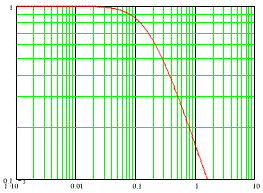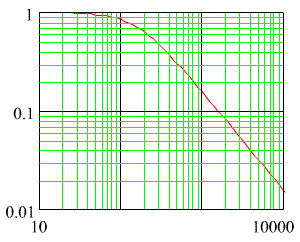Bode' Plots
Why Bode' Plots?
Bode plots are the most widely
used means of displaying and communicating frequency response information. There
are many reasons for that.
 Bode'
plots are really log-log plots,
so they collapse a wide range of
frequencies (on the horizontal axis) and a
wide range of gains (on thevertical axis) into a viewable whole.
 In
Bode' plots, commonly encountered frequency responses have
a shape
that is simple. That
simple shape means that laboratory measurementscan easily be discerned to
have the common factors that lead to those shapes. For example, first order
systems have two straight line asymptotes and if you take data and plot a
Bode' plot from the data, you can pick out first order factors in a transfer
function from the straight line asymptotes.
You may have used Bode' plots
without knowing it. Stereo equipment - amplifiers, speakers, microphones,
headsets, etc. - often have frequency response specifications, and when you buy
that kind of equipment, you may have seen a Bode' plot used to communicate
frequency response specifications.
All in all, Bode' plots are
widely used, not just to specify or show a frequency response, but they also
give useful information for designing control systems. Stability criteria can be
interpreted on Bode' plots and there are numerous design techniques based on
Bode' plots.
You need to know how to use
Bode' plots when you encounter them in those situations, so this lesson will
help you to understand the basics of Bode' plots.
What do you need to learn about
Bode' plots? Here is a short summary:
- What is a Bode'
plot?
- How is
magnitude plotted? (dbs)
- How is phase
plotted? (degrees)
- How is
frequency plotted? (on a logarithmic scale)
- Given a Transfer
Function:
- Be able to plot
the Bode' plot, manually or with a math analysis program.
- Know that the
Bode' plot you generated "makes sense".
- Given a Bode Plot
for a System:
- Determine the
transfer function of thesystem represented by the Bode' plot.
What Are Bode' Plots?
Bode' plots are:
 Plots of frequency response. Gain and phase are displayed in separate plots.
Plots of frequency response. Gain and phase are displayed in separate plots.
 Logarithmic plots.
Logarithmic plots.
 The horizontal axis is frequency - plotted on a log scale. It can be either
f or w.
The horizontal axis is frequency - plotted on a log scale. It can be either
f or w.
 The vertical axis is gain, expressed in decibels - a logarithmic measure of
gain.
The vertical axis is gain, expressed in decibels - a logarithmic measure of
gain.
 Sometimes, the vertical axis is simply a gain on a logarithmic scale.
Sometimes, the vertical axis is simply a gain on a logarithmic scale.
Given these characteristics, you
still need to know what a Bode' plot looks like. Our strategy in this lesson
will be to examine some simple systems - first order and second order systems -
to see what Bode' plots for the frequency response of those systems look like.
We'll start with the simplest system first, and work from there. We will end by
looking at how those simple systems can be combined to make more complex systems
with more complex Bode' plots. Remember one of our goals above.
- Given a Transfer
Function:
- Be able to plot
the Bode' plot, manually or with a math analysis program.
Know that the Bode'
plot you generated "makes sense".
That's what
we will start with for first order systems.
Bode' Plots For
First Order Systems
In this section we will work on
that general goal for first order systems. Let's look at an example Bode' plot
for a first order system. Here's a plot for a sample transfer function.
G(jw)
= 1/(jwt+ 1)
with t=
.001
Here's the Bode' plot. Examine the
following points for this plot.

 The
low frequency asymptote,
 The
high frequency asymptote,
 The
"mid point" where
wt
= 1 That's at f = 159 Hz.
Let's look at the low frequency
asymptote first. Here's the transfer function.
G(jw)
= 1/(jwt+ 1)
If wis small, then the imaginary term in the denominator is small, and we have:
G(jw)
~= 1/(j0 + 1) = 1
The low frequency behavior of the plot shows that
the plot is flat at a value of 1.
Now, let's look at the high
frequency asymptote. Here's the transfer function.
G(jw) = 1/(j
wt+ 1)
If wis large, then the imaginary term in the denominator dominates, and we have:
G(j
w) ~= 1/j
wt
The magnitude of the gain is:
|G(jw)|
~= 1/wt
The gain drops off inversely with
frequency, but the Bode' plot drops off as a straight line. Hmmmm? That's very
interesting - that it is a straight line. The straight line high frequency
asymptote shouldn't be cause for consternation. If we have:
|G(w)|
~= 1/wt
Remember that the Bode' plot is log gain
vs log frequency, so let's look at the logarithm of the magnitude of the gain.
log(|G(jw)|)
= log(1/wt)= -log(wt)
= -log(w)
- log(t)
So, log gain depends linearly upon the log of
frequency (w)
for higher frequencies.
That's an important point to remember, and
it is also a reason Bode' plots are used so much. When the asymptotic behavior
- both at high frequencies and low frequencies - is straight line behavior, it
makes Bode' plots easier to sketch and
easier to understand.
Actually, we need to note that the slope
of this plot - at high frequencies - is just -1. Look again at the asymptotic
high frequency relationship between the gain and frequency.
log(|G(jw)|)
= -log(w)
- log(t)
When frequency increases by a factor of 10, log(w)
increases by 1.
 Therefore,
when frequency increases by a factor of 10, log(|G(jw)|)decreases
by 1. Therefore,
when frequency increases by a factor of 10, log(|G(jw)|)decreases
by 1.
 Therefore,
when frequency increases by a factor of 10, |G(jw)|
decreases by a factor of 10. Therefore,
when frequency increases by a factor of 10, |G(jw)|
decreases by a factor of 10.
From this discussion, we need to draw a
conclusion.
 When
frequency increases by a factor of 10, |G(jw)|
decreases by a factor of 10. When
frequency increases by a factor of 10, |G(jw)|
decreases by a factor of 10.

Check that conclusion on the plot to be
sure you understand what it means.
Here is a plot with the lower limit
extended.

Check going from f = 300 to f = 3000.
Does the gain
decrease by a factor of 10 when the frequency
increases by a factor of 10?
The last point we need to examine is the
behavior of the frequency response for frequencies between high frequency and
low frequency - what we referred to as the mid-point
earlier. If the frequency response function is given by:
G(jw)
= 1/(jwt+ 1)
 If
w= 1/t then
(taking that frequency as the mid-point), we have: If
w= 1/t then
(taking that frequency as the mid-point), we have:
G(jw)
= 1/(j + 1)
 The
magnitude of the gain is: The
magnitude of the gain is:
|G(jw)|
= 1/|j + 1| = 1/sqrt(2)
~= 0.707
 This
point is at w= 1000, or f =159Hz. This
point is at w= 1000, or f =159Hz.
There are some interesting things to note
about this frequency response. Consider the interactive graph below. On that
graph you can see the low frequency asymptote, the high frequency asymptote and
the point where the gain is .707 of the low frequency gain.
 Check
the intersection of the two lines. Check
the intersection of the two lines.
 The
intersection of the two lines occurs where w= 1/t. The
intersection of the two lines occurs where w= 1/t.
 For
obvious reasons, this intersection is called the
corner frequency. For
obvious reasons, this intersection is called the
corner frequency.
|

